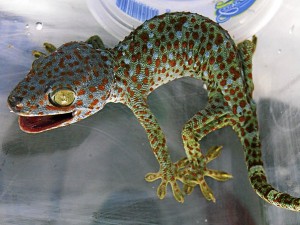MANILA, Philippines—A Philippine brown deer hobbles on three legs in a tiny mud pit of a pen at a government-run wildlife rescue center, a grim symbol of the country’s rapidly vanishing flora and fauna.
A Philippine brown deer hobbles on three legs in a tiny mud pit of a pen at a government-run wildlife rescue center, a grim symbol of the country’s rapidly vanishing flora and fauna.
The deer was a victim of a snare set by villagers hunting it for food that claimed its front right foot six years ago, forcing the old male to live out the rest of its days a long way from home at the animal shelter in Manila.
The deer is just one of hundreds of local species that are being hunted close to extinction mainly by the rural poor who want them for food or to sell to dealers as part of an increasingly lucrative global pet trade.
“It is in our culture to catch, kill, and or cook anything that moves,” said Mike Lu, treasurer of the Wild Bird Club of the Philippines, who has observed a dramatic decline in bird species over many years.
Massive habitat loss compounds the problem, according to Theresa Mundita Lim, head of the government’s Protected Areas and Wildlife Bureau.
Gone in 20 years
“One-fifth of our major fauna species will disappear within 20 years’ time if we don’t do something,” Lim said.
With more than 53,000 species, the environment group Conservation International lists the tropical Southeast Asian nation among 17 “megadiverse” countries that harbor two-thirds of Earth’s species.
But it also says the Philippines is one of the world’s most threatened hotspots, with just seven percent of its original forests left and one of the world’s fastest-growing populations that needs ever-greater amounts of land.
But, with roughly a third of the 95 million Filipinos living on a dollar a day or less, the immediate value of the country’s biodiversity is one of its greatest threats, according to Lim.
As an example, Lim said the poor rural villagers had nearly wiped out the country’s indigenous orchid species by collecting and selling them.
“It is the main livelihood for some communities,” she said.
The Philippines’ biodiversity riches makes it a major force in the global illegal wildlife trade, which is worth up to $20 billion annually, according to the Association of Southeast Asian Nations (Asean) Wildlife Enforcement Network.
Next to arms, drugs
The network says wildlife is the world’s third-largest black market trade, surpassed only by arms and drugs.
Among the higher-profile animal species to have all but vanished in recent years due to hunting are the brown deer and the national bird, a monkey-eating eagle.
And only about 200 tamaraws, a wild buffalo, remain at a protected mountain range.
Some of the prices are astounding.
Several species of geckos, colorful nocturnal lizards, are collected for the alternative medicine trade, with those believed to cure Aids selling for up to $1,200, while some of the rarest Philippine birds of prey are rumored to fetch upwards of $20,000, according to Lim.
She said trappers—typically poor farmers—got as little as P500 or about $12 for a coveted Philippine parrot, but middlemen then sold the critically endangered bird for five times that.
Arranque, Cartimar
The Aquino administration, which came to power last year, has stepped up efforts to combat the rampant wildlife trade.
High-profile police raids of pet shop and trophy suppliers this year have uncovered a wide range of rare or critically endangered species, including sea turtles, snakes and corals.
Protected wildlife used to be openly hawked at big pet markets such as Arranque in Manila’s Chinatown and Cartimar near the Makati City financial district.
A recent visit by Agence France Presse to Arranque found no prohibited species, and market administrator Rene Sese said the shopkeepers now observe a wildlife ban.
“Before that was a practice here. Now they only sell those bred in captivity,” Sese said.
Under the table
But the government acknowledges that, despite the higher-profile markets appearing to be better behaved, the illicit trade in protected species continues to flourish under the table.
“Traders are aware that they can be monitored so what they do is offer it for sale clandestinely… you can get it if you want. You can order,” Lim said, adding the Internet also fueled the trade.
Ashley Fruno, senior Asia campaigner for the animal rights group People for the Ethical Treatment of Animals, also said penalties remained far too light to dissuade people from participating in the lucrative trade.
A wildlife protection law was passed in the Philippines in 2001, but fewer than 20 people have been convicted and judges often fine them instead of sending them to jail, said Josefina de Leon, wildlife section head of the environment department.
Originally posted at 08:57 pm | Thursday, September 22, 2011


